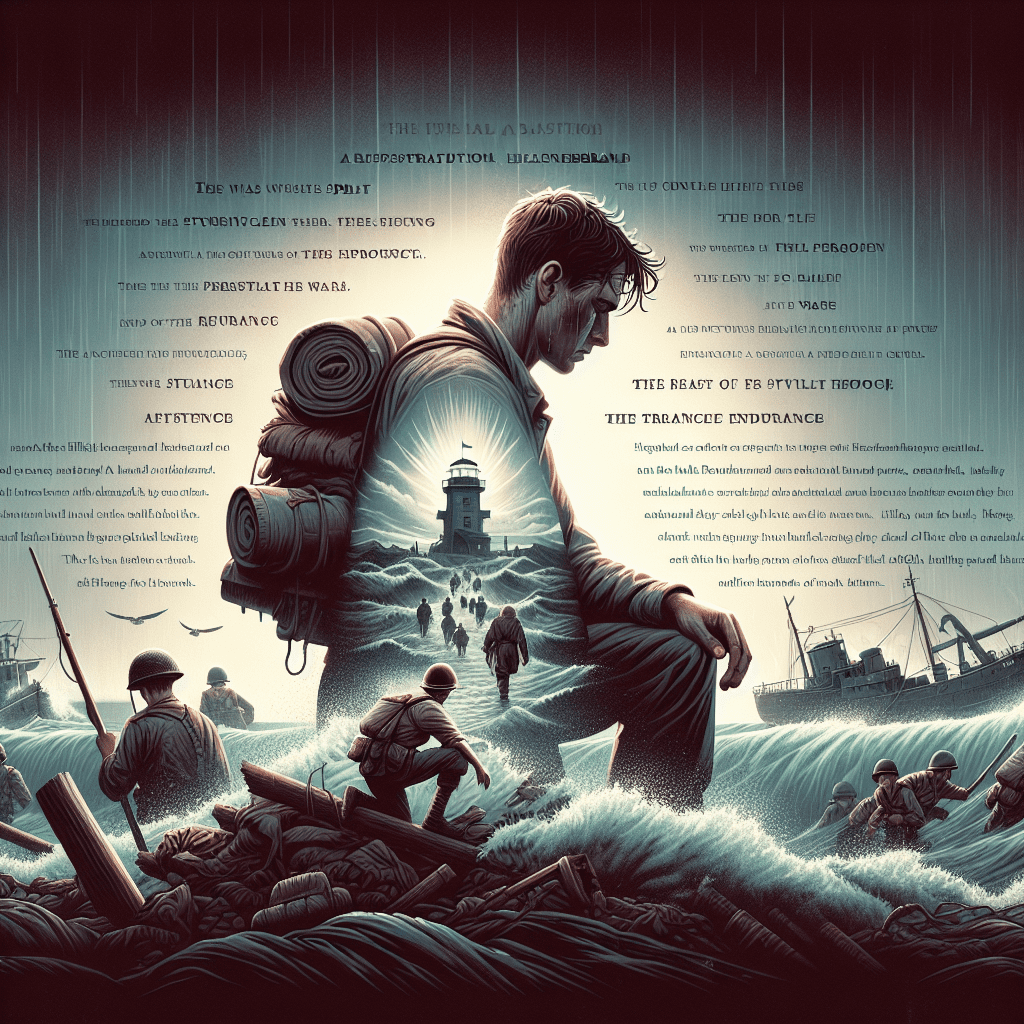-
Table des matières
“Unbroken: A gripping tale of resilience, redemption, and the indomitable human spirit.”
“Unbroken” by Laura Hillenbrand is a gripping non-fiction narrative that chronicles the extraordinary life of Louis Zamperini, an Olympic athlete and World War II bombardier. The book explores themes of resilience, survival, and the enduring human spirit as it follows Zamperini’s harrowing experiences, from his time as a soldier to his survival in the Pacific Ocean after a plane crash, and his subsequent ordeal as a prisoner of war in Japan. Hillenbrand delves into the psychological and physical challenges Zamperini faced, highlighting his determination to overcome adversity. The characters in the story, including Zamperini himself, his fellow soldiers, and his captors, are vividly portrayed, each contributing to the overarching narrative of hope and redemption. Through meticulous research and compelling storytelling, “Unbroken” serves as a testament to the strength of the human spirit in the face of unimaginable hardship.
Summary of Unbroken by Laura Hillenbrand
“Unbroken” by Laura Hillenbrand is a gripping narrative that chronicles the extraordinary life of Louis Zamperini, an Olympic athlete turned World War II bombardier. The book begins with Zamperini’s early years in Torrance, California, where his rebellious spirit and athletic prowess set the stage for a life marked by both triumph and adversity. Hillenbrand meticulously details his journey from a troubled youth to a celebrated runner, highlighting his participation in the 1936 Berlin Olympics, where he competed against the backdrop of rising global tensions.
As the narrative unfolds, the focus shifts to Zamperini’s military service during World War II. He becomes a bombardier on a B-24 Liberator named the “Green Hornet.” The author vividly describes the harrowing missions that Zamperini and his crew undertake, emphasizing the dangers they face in the Pacific theater. However, the story takes a dramatic turn when the Green Hornet crashes into the ocean due to mechanical failure, leaving Zamperini and two other crew members stranded on a life raft in the vast expanse of the Pacific. This segment of the book is particularly gripping, as Hillenbrand captures the physical and psychological challenges they endure while battling starvation, dehydration, and the relentless sun.
The narrative further intensifies as Zamperini and his fellow survivors, Phil and Mac, drift for weeks without rescue. Their ordeal is marked by moments of hope and despair, as they confront not only the elements but also the psychological toll of their situation. The author skillfully interweaves themes of resilience and survival, illustrating how Zamperini’s indomitable spirit helps him endure the unimaginable hardships of life at sea. Ultimately, their plight takes a tragic turn when they are discovered by the Japanese Navy, leading to Zamperini’s capture and subsequent imprisonment in a series of brutal POW camps.
Hillenbrand does not shy away from depicting the horrific conditions Zamperini faces during his captivity. The narrative delves into the cruelty of his captors, particularly a sadistic guard known as “The Bird,” who takes a particular interest in tormenting Zamperini. The author’s detailed descriptions of the physical and emotional abuse Zamperini endures serve to highlight the resilience of the human spirit in the face of unimaginable suffering. Throughout this harrowing experience, Zamperini’s memories of his past, particularly his love for running and his family, provide him with a glimmer of hope and a reason to survive.
As the war comes to an end, Zamperini is liberated, but his struggles are far from over. The psychological scars of his experiences haunt him, leading to a battle with post-traumatic stress disorder (PTSD) that threatens to consume him. Hillenbrand poignantly captures this internal struggle, illustrating how Zamperini’s journey toward healing is fraught with challenges. Ultimately, the narrative culminates in a powerful message of redemption and forgiveness, as Zamperini finds solace through faith and reconciliation, transforming his life from one of despair to one of purpose.
In summary, “Unbroken” is not merely a tale of survival; it is a profound exploration of the human capacity for resilience, the impact of trauma, and the possibility of redemption. Hillenbrand’s masterful storytelling brings to life the remarkable journey of Louis Zamperini, leaving readers with a lasting impression of courage and hope in the face of adversity.
Thèmes clés dans Unbroken
In “Unbroken,” Laura Hillenbrand explores several key themes that resonate deeply with the human experience, particularly those of resilience, the struggle for survival, and the quest for redemption. At the heart of the narrative is the extraordinary life of Louis Zamperini, an Olympic athlete turned World War II bombardier, whose journey encapsulates the essence of perseverance in the face of insurmountable odds. Hillenbrand meticulously details Zamperini’s harrowing experiences, from his time as a soldier to his survival on a life raft in the Pacific Ocean, and ultimately, his harrowing ordeal as a prisoner of war. Through these experiences, the theme of resilience emerges as a central pillar of the story, illustrating how the human spirit can endure even the most brutal circumstances.
Moreover, the theme of survival is intricately woven into the fabric of Zamperini’s life. Hillenbrand vividly recounts the physical and psychological challenges he faced while stranded at sea, where he battled starvation, exposure, and the constant threat of sharks. This struggle for survival is not merely a fight against nature but also a testament to the strength of the human will. Zamperini’s ability to cling to hope and maintain his resolve in the direst situations serves as a powerful reminder of the instinctual drive to live, which is a fundamental aspect of the human condition. As readers follow his journey, they are compelled to reflect on their own capacities for endurance and the lengths to which one might go to survive.
In addition to resilience and survival, the theme of redemption plays a significant role in “Unbroken.” After enduring the physical and emotional scars of war, Zamperini’s post-war life is marked by struggles with anger, alcoholism, and the haunting memories of his experiences. Hillenbrand delves into the psychological toll that trauma can take on an individual, illustrating how the aftermath of war can lead to a profound sense of disconnection and despair. However, the narrative takes a transformative turn when Zamperini encounters the teachings of faith and forgiveness. This pivotal moment highlights the theme of redemption, as he learns to confront his past and ultimately finds peace through forgiveness, not only for his captors but also for himself. This journey toward redemption underscores the idea that healing is possible, even after the most devastating experiences.
Furthermore, Hillenbrand emphasizes the importance of community and support throughout Zamperini’s life. The relationships he forms, whether with fellow soldiers, family members, or mentors, play a crucial role in his ability to navigate the challenges he faces. This theme of interconnectedness serves as a reminder that while individual strength is vital, the support of others can be equally transformative. The bonds that Zamperini cultivates throughout his life illustrate the profound impact that love, friendship, and camaraderie can have on one’s ability to overcome adversity.
In conclusion, “Unbroken” is a rich tapestry of themes that explore the complexities of the human experience. Through the lens of Louis Zamperini’s life, Hillenbrand masterfully examines resilience, survival, and redemption, inviting readers to reflect on their own journeys. The narrative serves not only as a historical account but also as an inspiring testament to the enduring strength of the human spirit, reminding us that even in the darkest of times, hope and healing are within reach.
Analyse du personnage de Louis Zamperini
In Laura Hillenbrand’s “Unbroken,” the character of Louis Zamperini emerges as a complex figure whose life story encapsulates resilience, determination, and the indomitable human spirit. Born in 1917 to Italian immigrant parents in Torrance, California, Louis’s early years were marked by a rebellious streak and a penchant for running, which would later serve as a foundation for his remarkable athletic career. His talent in track and field earned him a spot in the 1936 Berlin Olympics, where he competed against the world’s best athletes. This early success not only shaped his identity but also instilled in him a sense of ambition and a desire to overcome obstacles, traits that would prove crucial in the face of adversity.
As World War II erupted, Zamperini enlisted in the Army Air Corps, where he served as a bombardier. His experiences during the war were harrowing, particularly during a fateful mission over the Pacific Ocean that resulted in the crash of his B-24 bomber, the Green Hornet. Surviving the crash was only the beginning of his ordeal, as he and a small group of crew members found themselves stranded on a life raft in the vast ocean. The struggle for survival against the elements, starvation, and the psychological toll of isolation showcased Zamperini’s extraordinary will to live. His resourcefulness and determination during this period highlighted his ability to confront seemingly insurmountable challenges, a theme that resonates throughout the narrative.
However, the trials Zamperini faced did not end with his rescue. Captured by the Japanese Navy, he was subjected to brutal treatment in a series of prisoner-of-war camps. The character of Louis Zamperini is further developed through his experiences of torture and dehumanization, which tested the limits of his endurance and spirit. Despite the physical and psychological torment he endured, Zamperini’s resilience shone through. He became a symbol of hope and defiance, refusing to be broken by his captors. This aspect of his character illustrates the theme of perseverance in the face of adversity, as he clung to the memories of his past and the hope of freedom.
Moreover, Zamperini’s journey is not solely one of survival; it is also a profound exploration of forgiveness and redemption. After the war, he struggled with post-traumatic stress disorder, haunted by the memories of his experiences and the actions he had to take to survive. This internal conflict is a critical aspect of his character development, as it reflects the broader human struggle to reconcile with trauma and find peace. Ultimately, Zamperini’s encounter with faith and his decision to forgive his captors, particularly the infamous camp commander Mutsuhiro Watanabe, marks a significant turning point in his life. This act of forgiveness not only liberated him from the shackles of anger and resentment but also underscored the transformative power of compassion.
In conclusion, Louis Zamperini’s character in “Unbroken” serves as a testament to the resilience of the human spirit. His journey from a troubled youth to an Olympic athlete, a war hero, and a survivor of unimaginable hardships illustrates the complexities of human experience. Through his trials, Hillenbrand crafts a narrative that emphasizes themes of perseverance, forgiveness, and redemption, ultimately portraying Zamperini as a symbol of hope and strength. His story resonates with readers, reminding us of the capacity for resilience that lies within us all, even in the darkest of times.
Le rôle de la résilience dans Unbroken
In Laura Hillenbrand’s compelling narrative, “Unbroken,” resilience emerges as a central theme that intricately weaves through the life of Louis Zamperini, the protagonist whose journey from a troubled youth to a celebrated Olympic athlete and World War II bombardier is marked by extraordinary challenges. The story unfolds against the backdrop of adversity, illustrating how resilience is not merely a trait but a vital force that propels individuals to overcome insurmountable obstacles. Zamperini’s early life is characterized by a rebellious spirit and a penchant for running, which ultimately leads him to the Olympic Games. However, it is his experiences during the war that truly test his resilience.
As a bombardier in the Pacific theater, Zamperini’s plane crashes into the ocean, leaving him stranded on a life raft with two fellow crew members. The harrowing days that follow are a testament to human endurance. Faced with starvation, exposure to the elements, and the psychological toll of isolation, Zamperini’s resilience shines through. He embodies the idea that the human spirit can withstand even the most dire circumstances. The struggle for survival becomes a profound exploration of hope and determination, as Zamperini and his companions cling to life against all odds. This period of his life not only highlights the physical challenges he endures but also emphasizes the mental fortitude required to persevere.
Transitioning from the ocean to the confines of a Japanese POW camp, Zamperini’s resilience is further tested. The brutal conditions and relentless cruelty inflicted by his captors serve as a stark contrast to the hope he clung to during his time at sea. Here, Hillenbrand delves into the psychological aspects of resilience, illustrating how Zamperini’s spirit is battered yet unbroken. The narrative reveals that resilience is not simply about enduring hardship; it also involves the capacity to maintain one’s identity and humanity in the face of dehumanization. Zamperini’s refusal to succumb to despair, even when subjected to unimaginable suffering, underscores the profound strength of the human spirit.
Moreover, Hillenbrand emphasizes that resilience is not a solitary endeavor. The bonds formed between Zamperini and his fellow prisoners play a crucial role in their survival. This interconnectedness highlights the importance of community and support in fostering resilience. As they endure the trials of captivity together, their shared experiences create a sense of solidarity that bolsters their resolve. This aspect of the narrative serves as a reminder that resilience can be cultivated through relationships, reinforcing the idea that individuals are often stronger together.
Ultimately, “Unbroken” culminates in Zamperini’s post-war struggles, where he grapples with the psychological scars left by his experiences. The journey toward healing is yet another testament to resilience, as he learns to confront his demons and find peace. Hillenbrand’s portrayal of Zamperini’s life illustrates that resilience is not a finite resource but rather a dynamic process that evolves over time. It is through this lens that readers come to understand resilience as a multifaceted concept, encompassing not only the ability to endure but also the capacity for growth and transformation.
In conclusion, “Unbroken” serves as a powerful exploration of resilience, showcasing how it can manifest in various forms throughout an individual’s life. Through Louis Zamperini’s extraordinary journey, Hillenbrand invites readers to reflect on the strength of the human spirit and the profound impact of resilience in overcoming adversity. The narrative ultimately leaves an indelible mark, inspiring a deeper appreciation for the resilience that resides within us all.
Historical Context of World War II in Unbroken
In “Unbroken,” Laura Hillenbrand intricately weaves the historical context of World War II into the narrative of Louis Zamperini, a former Olympic athlete turned bombardier in the U.S. Army Air Forces. The backdrop of the war is not merely a setting but a catalyst that shapes the lives of the characters and the trajectory of the story. The global conflict, which lasted from 1939 to 1945, was marked by unprecedented levels of violence and destruction, fundamentally altering the course of history. Hillenbrand captures the essence of this tumultuous period, illustrating how the war’s chaos and brutality impacted individuals and nations alike.
As the narrative unfolds, readers are introduced to the harsh realities faced by soldiers during the war. The Pacific Theater, where Zamperini served, was characterized by fierce battles, including the infamous bombing of Pearl Harbor, which propelled the United States into the conflict. The author meticulously details the harrowing experiences of airmen, who often faced perilous missions with little regard for their safety. The psychological and physical toll of these missions is evident in Zamperini’s story, as he navigates the dangers of aerial warfare, including mechanical failures and enemy fire. This portrayal serves to highlight the broader context of military strategy and the high stakes involved in the fight against Axis powers.
Moreover, Hillenbrand delves into the experiences of prisoners of war, a significant aspect of World War II that is often overshadowed by the more prominent battles. Zamperini’s harrowing journey as a POW in Japanese camps reveals the inhumane treatment that many soldiers endured. The author provides a stark depiction of the brutality inflicted upon captives, emphasizing the psychological warfare that accompanied physical torture. This exploration of resilience in the face of adversity is a central theme in “Unbroken,” as Zamperini’s spirit is tested time and again. The historical context of the war amplifies the significance of his survival, illustrating the broader struggle for dignity and humanity amidst the horrors of conflict.
In addition to the immediate experiences of soldiers and POWs, Hillenbrand also contextualizes the war within the larger framework of global politics and ideology. The rise of militarism in Japan and the expansionist ambitions of the Axis powers created a volatile environment that necessitated a unified response from the Allied forces. This geopolitical landscape is crucial for understanding the motivations behind military actions and the sacrifices made by individuals like Zamperini. The author effectively conveys how these historical forces converged to shape the lives of countless individuals, making their personal stories emblematic of the broader human experience during the war.
Furthermore, Hillenbrand’s narrative underscores the lasting impact of World War II on post-war society. The psychological scars borne by veterans, including Zamperini, reflect the challenges of reintegration into civilian life after experiencing the trauma of war. The author highlights the struggles with PTSD and the search for meaning that many veterans faced, illustrating how the war’s legacy continued to affect individuals long after the fighting had ceased. In this way, “Unbroken” serves not only as a biography of Zamperini but also as a poignant reminder of the enduring consequences of global conflict.
Through her meticulous research and compelling storytelling, Laura Hillenbrand provides readers with a profound understanding of the historical context of World War II in “Unbroken.” By intertwining Zamperini’s personal journey with the broader narrative of the war, she illuminates the complexities of human resilience and the indomitable spirit that can emerge even in the darkest of times.
The Impact of Forgiveness in Unbroken
In Laura Hillenbrand’s “Unbroken,” the theme of forgiveness emerges as a powerful and transformative force that shapes the lives of the characters, particularly that of Louis Zamperini. The narrative chronicles Zamperini’s harrowing experiences as a World War II bombardier, his survival in the Pacific Ocean, and his subsequent imprisonment in Japanese POW camps. Throughout these trials, the concept of forgiveness becomes a pivotal element, influencing not only Zamperini’s personal journey but also the broader implications of healing and reconciliation.
Initially, Zamperini’s experiences in the war and as a prisoner lead him to harbor deep-seated resentment and anger towards his captors. The brutal treatment he endures at the hands of the Japanese soldiers, particularly the sadistic camp guard known as “The Bird,” instills in him a desire for revenge. This desire is a natural response to the trauma he faces, reflecting a common human reaction to suffering and injustice. However, as the narrative unfolds, it becomes evident that this anger is ultimately self-destructive. Hillenbrand illustrates how Zamperini’s inability to let go of his hatred manifests in his post-war life, leading him to struggle with alcoholism and emotional turmoil. This portrayal underscores the idea that holding onto resentment can hinder personal growth and healing.
The turning point in Zamperini’s journey comes when he encounters the concept of forgiveness, which is catalyzed by his conversion to Christianity. During a pivotal moment at a Billy Graham revival meeting, Zamperini experiences a profound spiritual awakening that compels him to confront his past. This moment of clarity allows him to recognize that forgiveness is not merely an act of absolution for others but a necessary step for his own liberation. Hillenbrand effectively conveys that forgiveness is a choice, one that requires immense courage and strength. By choosing to forgive, Zamperini begins to reclaim his life from the shadows of his traumatic experiences.
Moreover, the impact of forgiveness extends beyond Zamperini himself; it resonates throughout his relationships and interactions with others. As he learns to forgive, he also becomes a source of inspiration for those around him. His journey illustrates the ripple effect that forgiveness can have, fostering healing not only within oneself but also within the community. Hillenbrand emphasizes that forgiveness can bridge divides, allowing individuals to move forward from their pasts and build new connections based on understanding and compassion.
In addition, the theme of forgiveness in “Unbroken” serves as a commentary on the broader human experience. Hillenbrand suggests that forgiveness is a universal necessity, particularly in the aftermath of conflict and suffering. By highlighting Zamperini’s transformation, she invites readers to reflect on their own lives and the grudges they may carry. The narrative ultimately posits that forgiveness is not a sign of weakness but rather an act of profound strength, enabling individuals to transcend their pain and embrace a future filled with hope.
In conclusion, the impact of forgiveness in “Unbroken” is multifaceted, influencing both the protagonist’s personal journey and the lives of those around him. Hillenbrand masterfully weaves this theme throughout the narrative, illustrating how forgiveness can serve as a catalyst for healing and transformation. Through Zamperini’s story, readers are reminded of the power of forgiveness to liberate the soul and foster resilience in the face of adversity.
Symbolism and Motifs in Unbroken
In “Unbroken,” Laura Hillenbrand weaves a rich tapestry of symbolism and motifs that enhance the narrative and deepen the reader’s understanding of the themes presented throughout the book. One of the most prominent symbols is the character of Louis Zamperini himself, who embodies resilience and the indomitable human spirit. His journey from a troubled youth to an Olympic athlete and then to a World War II bombardier serves as a powerful representation of the struggle against adversity. Zamperini’s life is marked by a series of challenges that test his limits, and through these experiences, Hillenbrand illustrates the broader theme of survival against overwhelming odds.
Another significant motif in “Unbroken” is the recurring imagery of flight. The planes that Zamperini and his fellow airmen pilot symbolize freedom and the pursuit of dreams, yet they also represent the fragility of life. The contrast between the exhilaration of soaring through the skies and the harsh reality of war is poignantly depicted, highlighting the duality of human experience. As Zamperini navigates the dangers of aerial combat, the planes become a metaphor for both hope and despair, encapsulating the highs and lows of his journey.
Moreover, the ocean serves as a powerful symbol throughout the narrative. After Zamperini’s plane crashes into the Pacific, he and his fellow survivors are left adrift on a life raft, surrounded by vast, unforgiving waters. The ocean represents both a source of sustenance and a formidable adversary, reflecting the unpredictability of life itself. As they struggle to survive against starvation, exposure, and the threat of sharks, the ocean becomes a character in its own right, embodying the relentless challenges that Zamperini must confront. This motif underscores the theme of endurance, as the survivors cling to hope amidst despair, illustrating the human capacity to persevere even in the direst circumstances.
In addition to these symbols, Hillenbrand employs the motif of faith and redemption, particularly in the latter part of Zamperini’s life. His experiences as a prisoner of war in Japan serve as a crucible for his character, testing his beliefs and resolve. The brutality he endures at the hands of his captors forces him to confront his own limitations and ultimately leads him to a profound spiritual awakening. This transformation is emblematic of the broader theme of redemption, as Zamperini learns to forgive those who wronged him, finding peace in the process. Hillenbrand’s exploration of faith is intricately tied to the narrative, illustrating how belief can serve as a source of strength in the face of unimaginable suffering.
Furthermore, the motif of the Olympic Games recurs throughout the text, symbolizing not only Zamperini’s personal aspirations but also the universal pursuit of excellence and achievement. His early success as a runner serves as a foundation for his later resilience, reinforcing the idea that the qualities developed through sport—discipline, determination, and perseverance—are essential for overcoming life’s challenges. Hillenbrand effectively intertwines these motifs and symbols, creating a narrative that resonates on multiple levels, ultimately portraying the triumph of the human spirit in the face of adversity. Through Zamperini’s story, readers are invited to reflect on their own struggles and the enduring power of hope, resilience, and redemption.
Q&R
1. **Quelle est l'idée principale de "Unbroken" ?
“Unbroken” tells the true story of Louis Zamperini, a former Olympic athlete and World War II bombardier who survives a plane crash, drifting at sea for weeks, and enduring brutal treatment as a prisoner of war.
2. **Quels sont les principaux thèmes abordés dans "Unbroken" ?
Les thèmes principaux sont la résilience, le pouvoir de l'esprit humain, l'impact des traumatismes, le pardon et la lutte pour la rédemption.
3. **Qui est le protagoniste de "Unbroken" ?
Le protagoniste est Louis Zamperini, dont la vie englobe ses exploits sportifs, ses expériences en temps de guerre et les défis de l'après-guerre.
4. **Quels sont les défis auxquels Louis Zamperini est confronté pendant la guerre ?
Il doit faire face à un accident d'avion, survivre en mer avec des ressources limitées et subir de graves mauvais traitements en tant que prisonnier de guerre dans les camps japonais.
5. **Comment le passé sportif de Louis influence-t-il ses expériences ?
Sa détermination et son esprit de compétition, aiguisés par des années de course à pied, l'aident à supporter les épreuves physiques et mentales pendant la guerre et la captivité.
6. **Quel rôle joue le pardon dans le récit ?
Le pardon est un élément crucial, en particulier dans le cheminement de Louis vers la guérison de ses expériences traumatisantes et dans sa décision finale de pardonner à ses ravisseurs.
7. **Quelle est la signification du titre "Unbroken" ?
Le titre reflète l'esprit inébranlable et la résilience de Louis Zamperini face à une adversité écrasante, symbolisant sa capacité à endurer et à surmonter les défis de la vie. "Unbroken" de Laura Hillenbrand est un récit puissant qui retrace la vie de Louis Zamperini, un athlète olympique et bombardier de la Seconde Guerre mondiale qui survit à un accident d'avion, à la dérive en mer et à un traitement brutal en tant que prisonnier de guerre. Les thèmes de la résilience, de la capacité de l'esprit humain à endurer la souffrance et de la quête de rédemption sont au cœur de l'histoire. En décrivant le parcours de Zamperini, Hillenbrand met en évidence l'impact des traumatismes et l'importance de l'espoir et du pardon. Les personnages, en particulier Zamperini, incarnent la lutte contre l'adversité et la force de la persévérance. En fin de compte, "Unbroken" est un témoignage de la nature indomptable de l'esprit humain face à des défis inimaginables.







